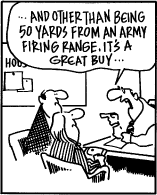Home > Home Buyers Learning Center > Step 6
6. Conduct Home Search

Now that you have established the price range you are comfortable with, chosen a lender, and received your pre-approval letter, you and your REALTOR® representative are ready to start looking at homes.
The criteria you established when identifying your needs such as the maximum commute time tolerable to your place of employment, neighborhood amenities, school districts, etc. have helped to narrow the possibilities where your new home could possibly exist. Even so you may still be faced with many choices. Your REALTOR® can be invaluable when it comes to helping you make informed decisions.
NOTE: Under Federal Housing Laws it is unlawful for a real estate professional to engage in conduct that is discriminatory on the basis of race, religion, color, national origin, sex, handicap or familial status. A real estate professional should never steer you towards or away from a particular neighborhood if the homes there fit your needs and are within your range of affordability.
A. Factors to Consider When Evaluating a Neighborhood

Spending time in a neighborhood can tell you a lot about it, but not everything. You also need to do some research. Depending on your particular needs and preferences, some factors will be more important than other, but things to consider include:
- Neighborhood Profile: Research neighborhood aspects such as population density and the level of commercial development. Ask yourself "What kind of neighborhood do I want to live in?" City? Suburban? Small town? Rural?
- Household Data: Take into account family type, average household income and homeowner education level and occupation.
- Crime Rate: Crime is an unfortunate reality we must all deal with. No neighborhood is totally immune from the risk if crime, but by researching the incidences of reported crime in the neighborhoods you are considering you can make an educated decision about where to live. Visiting these neighborhoods at night can also help you get a feeling about how safe they are. To locate where sex offenders live visit: Virginia Sex Offender and Crimes Against Minors Registry
- Quality of Schools: Base your evaluation on school performance, as determined by average test scores, spending per student, and the percentage of college bound students and national merit scholars. Visit schools personally and talk with the school administration and teachers. School comparisons can be found at SchoolMatters.com
- Amenities: What features you want in a neighborhood will be determined by the lifestyle you lead. Amenities to consider include proximity to: schools, place of employment, shopping, transportation, parks and recreation, restaurants and nightlife, cultural institutions, and natural resources, such as state parks.
B. Neighborhood Search Strategies
Finding the right neighborhood is an inexact science, but try incorporating some of these strategies as you evaluate different areas:
- Neighborhoods become "hot," and home prices there increase sharply. Rather than looking in an area that has already been "discovered," consider looking in nearby neighborhoods that have not yet experienced drastic rises in home values.
- Look in neighborhoods that are more rural yet close to public transportation if commuting is a concern. Prices tend to decrease the farther you are away from city center.
- To assess demand in a neighborhood take note of the number of "for sale," "sale pending," and "sold" signs. Ask you buyer’s representative if multiple offers are being made on neighborhood properties. Also research the gap between list prices and sale prices, and how long the properties were listed before sale. If properties are selling for more than list, demand in the neighborhood is high; longer times to sale could indicate a cooling market.
- If you are considering new construction, it is typically better to buy into a new development early on rather than purchasing one of the last homes built. Builders implement periodic price increases to compensate for rising costs of labor and materials. As a result, your home correspondently goes up in value. The trade off is you must be willing to deal the ongoing construction until the development is complete.
- Be flexible in the type of housing you will consider. By remaining open to a condominium or townhouse, rather than a detached house, you may be able to live in a more desirable neighborhood than you could otherwise afford.
C. Using Websites
The internet makes shopping for a home easier than ever. Make sure the website you are searching includes all the homes listed for sale with the Multiple Listing Service (MLS) for the cities/counties in which you want to live. Remax.com includes all homes listed for sale in Hampton Roads, Virginia to include bank owned (REO) properties, HUD homes and VA foreclosures. Remax.com offers advanced and map search features, virtual tours of homes and removes homes from their website once they go under contract and are no longer available for sale.
D. Use a Home Comparison Worksheet
Evaluate the homes you have viewed by comparing their features side-by-side. Remember, however, purchasing a property is more than just an investment, it’s a home. A place where you will experience many happy events creating memories that will last a lifetime. Don’t fall into analysis paralysis. Depending on market conditions, you may have to act quickly.

Your friends can probably tell you stories about someone who looked far and wide for their dream home, finally found it, delayed taking action and lost the home. Buying your new home is an emotional decision tempered with just the right amount of logic. When you get that special feeling upon entering one of the homes you have viewed, don’t be afraid to move forward and make an offer.
Congratulations, You Have Graduated to the Next Step >>
Back to Top




